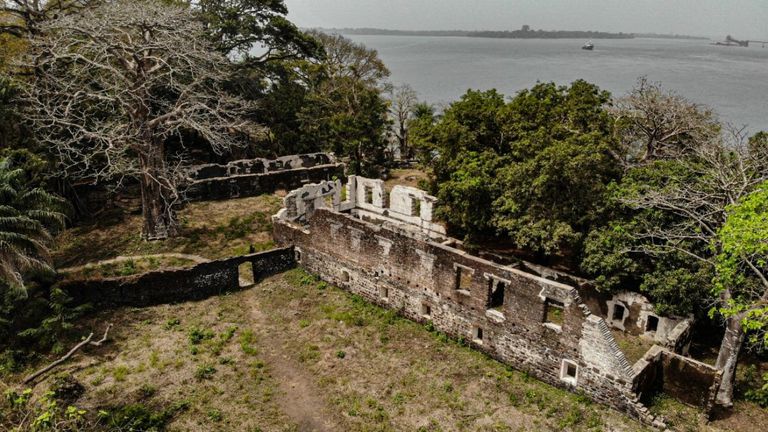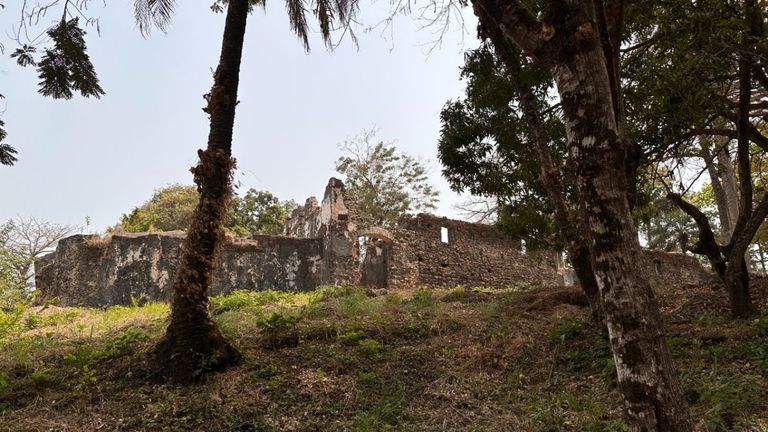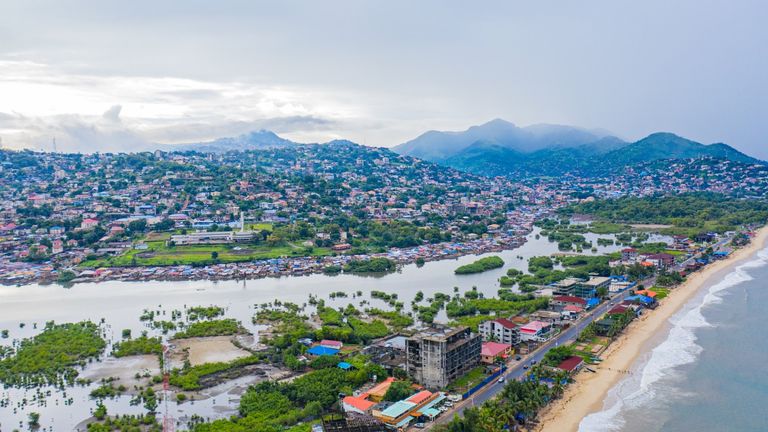As our boat slowly approached the quiet shores of the uninhabited island, it was hard to shake the feeling of being transported back into a dark chapter of history. Stepping onshore, I could see this was a place forgotten by time; its ancient structures had decayed over two centuries of tropical rain and neglect.
We were standing on Bunce Island in the West African country of Sierra Leone. Located some 18 miles from the capital of Freetown, this tiny strip of land once served as a major post for the transatlantic slave trade, and for more than a century, it was the site of some gruesome acts.
“This is the official last door of no return,” said Peter Momoh Bassie, our guide. “People taken from all over Africa would make their last stop here to be ‘trained’ before they were taken to slavery in the West.”
 The remains of Bunce Island Fort
The remains of Bunce Island Fort
Credit: 2024 Sarah KingdomTens of thousands of captive men, women and children were crowded inside Bunce Island's stone fort, shackled together and forced into holding pens. Here, they waited for weeks or months, before being marched onto a ship at the end of the island’s stony pier. Those who survived the subsequent 10-week journey across the Atlantic Ocean found themselves in an entirely new world: the plantations of the American colonies.
Some History of Bunce Island and Sierra Leone
Bunce is one of 40 forts once operated by enslavers along the West African coast. It was active almost continuously from 1670 to 1807 but was busiest in the mid-1700s. The island shut down with the U.K.’s abolition of the transatlantic slave trade in 1807 and was soon abandoned, sitting untouched and largely forgotten ever since. Today, more than 200 years later, the old slave fort is crumbling, blanketed with overgrown weeds, giant trees threatening to swallow it — and few outside of Sierra Leone even know of its existence.
Portuguese sailors were some of the first Europeans to discover the site of what is now Freetown. The name “Sierra Leone” dates back to 1462, when Portuguese explorer Pedro da Cintra was sailing down the west coast of Africa and saw the tall mountains on what is now known as the Freetown Peninsula; he called them the Lion Mountains, or Serra Lyoa. As foreign influence increased, trade commenced between the locals and Europeans.
The British began to take an interest in the area, and in 1672, the Royal African Company established trading forts on Bunce and York islands. With the emergence of the slave trade, human beings became the major commodity, and Bunce Island became a prime spot for the transporting of enslaved people to Europe and America.
 Travelers can visit Bunce Island and learn about its history with local tour operators.
Travelers can visit Bunce Island and learn about its history with local tour operators.
Credit: 2024 Sarah KingdomThe founding of modern-day Sierra Leone dates back to 1787, when several waves of freed slaves arrived from England. Two further waves of Black settlers came in 1792 and 1800 from Nova Scotia and Jamaica, respectively. In 1808, Sierra Leone became a British colony, and from then until 1874, Freetown was the headquarters of the Royal British Navy’s West African Squadron, which captured slave ships headed for the Americas and released the enslaved people into the city. From this point on, virtually all the new settlers to Sierra Leone were “re-captives,” a term used to describe rescued and emancipated people from the slave ships.
Tracing Sierra Leone to the U.S.
Historically, there’s a strong connection between the Gullah-Geechee people of the U.S. and the people of Sierra Leone, and both sides of the Atlantic are becoming more interested in learning about it.
“The African American story is very much here,” said American historian Joseph Opala about Bunce Island. “There are 40 big castles like this along the West African coast, but this is the only one that sent appreciable numbers of captives to what is now the U.S. It's the most important historic site in Africa for the U.S.”
Opala estimates that between a quarter and a fifth of all the men, women and children who departed Bunce Island in the 18th century ended up in what are today the U.S. states of South Carolina and Georgia.
"No other West African slave fort sent as many people directly to North America," he said.
Hints of Sierra Leonean culture are still visible today in the Gullah and Geechee communities along the Georgia and South Carolina coasts. Some people still eat rice three times per day, use some ancestral language or carry on other familiar traditions.
"In Gullah country – the low-country of South Carolina and Georgia – many of the people you meet will tell you their ancestors came from Sierra Leone," said Amadu Massally, a Sierra Leonean who runs heritage tours to Bunce Island through his company, Fambul Tik Tours (“fambul tik” translates to “family tree”).
“But, unfortunately, we don't have many African Americans coming to Sierra Leone yet. Many of them go to Ghana under the illusion that Ghana is the home of African Americans, but the slave castles in Ghana sent their captives to work on plantations in the West Indies, not to the American colonies.”
 Freetown is the modern-day capital of Sierra Leone.
Freetown is the modern-day capital of Sierra Leone.
Credit: 2024 Kalada/stock.adobe.comHeritage Travel to Sierra Leone and Beyond
At present, with its luxury hotels, well-maintained historic sites and direct flights from the U.S., Ghana attracts the bulk of “heritage” tourists. Though tourist infrastructure may be lacking in Sierra Leone, historians argue that African Americans are more likely to have roots in Sierra Leone than in Ghana. The strong connection between the U.S. and Sierra Leone is also turning up in DNA test results, which have become increasingly popular among African Americans. Poet Maya Angelou; activist, clergyman and politician Jesse Jackson; and actor Idris Elba are all prominent personalities who have discovered they have Sierra Leonean ancestors.
Standing on Bunce Island, I turned to talk to a friend and fellow journalist, Mitti Hicks, to ask her, as an African American, how the experience resonated with her.
“I was overwhelmed with emotion,” she said. “I stood there, tears flowing, reflecting on how I was possibly standing on the very place where my ancestors took their last steps before being taken to a foreign land, with unimaginable horror ahead. I was also disappointed that I knew so little about Bunce Island."
She went on to tell me that she stills sees the beauty of Sierra Leone, even through the history of the slave trade.
“Sierra Leone is ready to change this negative narrative, especially for people who look like me,” Hicks said. “Sierra Leone wants people of African descent to return for heritage tours. There’s vital history to learn and a direct cultural connection between the Gullah Geechee community in the U.S. and Sierra Leone.”
Bunce Island is haunting and eye-opening. Be sure to visit with a local guide who knows the place and can explain its history.
Navigating Sierra Leone
Sierra Leone is a destination that’s not easy to navigate alone; the best way to explore it is with a tour guide. Local guides will streamline the process of visas, transportation and currency exchange. (Note: ATMs are scarce, and many local shops do not take credit cards.)
For assistance planning travels in Sierra Leone, including heritage tourism, try Visit Sierra Leone, which offers the Bunce Island & Tasso Island Excursion, as well as a homecoming and passport tour. Alternatively, IPC Travel runs a number of slave history-related tours to various locations in the country.